by Brian Branciforte
Hickory Mound Wildlife Management Area
Picture this: You’re in a busy room at the Florida Capitol dominated by business attire and stiff procedure. It’s a legislative meeting in which state representatives put forth bills for the next session. Fitting into a hectic schedule, they’ve traveled here from around the state ready with their funding requests. Up next, a series of natural resource projects.
Most of these projects have a link to the natural environment such as wastewater treatment, habitat restoration, sea level rise, and improving parks. Presentations are given in rapid-fire succession; an incredulously fast one to three sentences each. They all pass through the legislative process with minimal questions or interest. The meeting is forcefully efficient and resembles an assembly line to get through the dozen or so projects. From one million dollars to just one hundred thousand, they all vary in price and scope, but it doesn’t seem to matter. It’s just procedure.
Every project appears to be well-intentioned, and you are aware not all of them will ultimately get funded. But as you sit there watching it all conclude, one sticking point screams out - where is the coordination to all of these seemingly one-off proposals? Why were these projects presented and which one gives the greatest benefits relative to cost and need? Perhaps these questions will be answered at another meeting, or perhaps these points were ironed out in the months or years leading up to this meeting. Better yet, maybe members and staff carefully vetted, combed through, and prioritized conservation need prior to today. Or cynically, maybe the fate of these projects rest simply on a few sentences and the chance of who’s ear is caught. After all, the democratic process can be cloudy.
While demanding and time-consuming, statewide coordination is critical to wildlife and conservation success. Given limited funding, natural resource organizations and agencies are well-aware of the need to prioritize projects and budgets. Within this realm, partnerships are essential to leveraging resources and for working through institutional barriers.
Landscape conservation encompasses these core principles and seeks to connect each local area and stakeholder into a greater umbrella. Landscape conservation is most successful when it involves reaching out and partnering with non-traditional stakeholders to build a wide-ranging base. From there, shared goals and measurable implementation can bring true progress for wildlife and people. FWC aims to do just this through its State Wildlife Action Plan, State Wildlife Grant funding, and partnership building.
Florida needs conservation champions leading a landscape approach with a culture of collaboration and science-informed decisions. Otherwise, much like the appearance of the legislative meeting, there will be many well-intentioned one-off projects vying for the same funding with no apparent coordinated strategy behind it…year after year.
Back to top
by Allie McCue
 |
|
We are pleased to announce Florida’s 2019 State Wildlife Action Plan has been approved by the U.S. Fish and Wildlife Service! Thank you to everyone who participated in the revision by writing, reviewing, or commenting on draft versions of the plan. In the coming weeks, we will be working to make the Action Plan more widely accessible. Until then, a PDF is available for download at MyFWC.com/WildlifeLegacy.
Stay tuned for information regarding webinars, new materials, and more. This revision has many new features and opportunities that vary from the 2012 Action Plan and we look forward to sharing them with you. For more information or questions regarding the Action Plan, please contact Allie McCue at Allie.McCue@MyFWC.com.
|
Back to top
by Anna Deyle
Florida’s Wildlife Legacy Initiative (FWLI) has two new team members! Amy Clifton and Victoria Ruddle were recently hired as new Wildlife Legacy Biologists in FWC’s North Central and South Regions. We are so excited to have both of them as part of our team!

Amy is based in FWC’s Lake City office and is the new lead for the Research and Monitoring Goal Team, which focuses on producing research and monitoring results that will improve management of Species of Greatest Conservation Need (SGCN) and their habitats. Amy has been with FWC for about nine years. Prior to moving to FWLI, she served as a Regional Species Conservation Biologist for FWC’s Regional Operations Subsection in the Southwest Region.
Amy received her Bachelor and Master of Science degrees in Biology from the University of Arkansas in Fayetteville. She has performed conservation work on multiple species including the Swainson’s warbler, ivory-billed woodpecker, red-cockaded woodpecker, and Rafinesque’s big-eared bat. Prior to working for FWC, she worked for Archbold Biological Station and the Florida Park Service (FPS). She served for a year on the FPS prescribed fire strike team, has her burn boss certification, and has participated in over 200 prescribed burns. Amy can be reached at Amy.Clifton@MyFWC.com
|
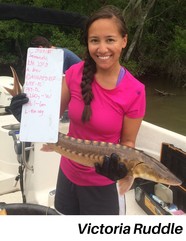
Victoria is the new Wildlife Legacy Biologist for the South Region and is based out of FWC’s West Palm Beach office. She is the lead for the Marine and Estuarine Enhancement Goal Team, which focuses on improving marine and estuarine ecosystem habitat quality for the benefit of Species of Greatest Conservation Need.
Victoria received her Bachelor of Science degree in Biology from St. Lawrence University in New York. She received her Master of Science degree in Marine Biology from the College of Charleston in South Carolina, where she studied the age structure and reproduction of Atlantic and Shortnose Sturgeon in the Cooper River. After completing her master’s degree, Victoria joined the U.S. Fish and Wildlife Service as a contractor and worked with the Wildlife and Sport Fish Restoration division on grant programs including State Wildlife Grants. Victoria can be reached at Victoria.Ruddle@MyFWC.com
|
Back to Top
by Allie McCue
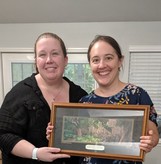
Congratulations to Anna Deyle, the Legacy award winner for 2019. Anna joined FWLI in the spring of 2018 as the Northeast Region Wildlife Legacy Biologist where she works to develop partnerships and leverage resources for wildlife conservation. As the lead for the Terrestrial Habitat Integrity Implementation Goal, Anna’s primary function is to increase fire-related management on priority upland habitat. In addition to her main job duties, she also co-leads the Space Coast Shorebird Partnership and is a Conserve Wildlife Tag Grant recipient for a coastal dunes crown snake research project. Anna has proved to be a great resource for new staff and an invaluable team member for FWLI. Her positive attitude, passion for wildlife, and quirky sense of humor make Anna a great person to work with! Congratulations Anna!
|
Back to Top
by Victoria Ruddle
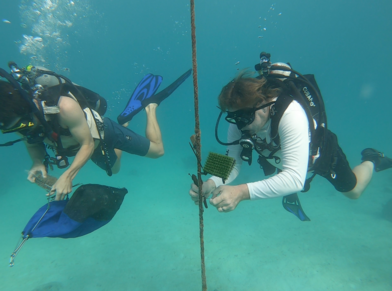
Left: Researchers Bill Sharp and Elliot Hart remove and replace larval urchin collectors suspended in the water column near Delta Shoal
In coral reef ecosystems, herbivores play an important role; by grazing on macroalgae, they enhance coral recruitment and prevent algae from suffocating sensitive corals. In the Caribbean, a mass mortality event of the long-spined urchin (Diadema antillarum), a keystone herbivore, is largely considered the cause for Florida’s significant loss of corals since the 1980s. This loss of corals and a shift toward algae-dominant marine habitat has also led to an absence of shelter for invertebrate herbivores. This has created a vicious cycle in which neither urchins or corals can thrive. In the Florida Keys, a SWG-funded project aims to break this cycle by creating habitat for long-spined urchins and subsequently improve herbivory on algae-dominate reefs.
|
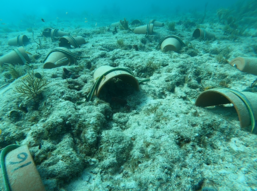
Right: Artificial shelter on Delta Shoal awaiting PIT-tagged long-spined urchins
I recently joined biologists Bill Sharp, Elliot Hart, and Christene Parsons in Marathon to see the project in action. Having just completed a comprehensive study of PIT tagging methodology, the wet lab at the FWC office in Marathon contains tanks filled with PIT-tagged urchins ready to be transferred to the reef. In the field, these urchins will be placed near artificial shelter on Delta Shoal, a reef just off the coast of Marathon. The artificial shelter is comprised of terracotta planters cut in half and secured to the reef surface, creating crevices for urchins to seek refuge. In previous studies, these terracotta shelters were found to improve survival of long-spined urchins on degraded reefs where natural shelter is no longer available. Sharp and his co-PIs hope to scale up this research to answer larger research questions: how can the addition of shelter quantifiably effect coral restoration and how can restoration be most effective? Transplanted urchins will be regularly located in order to determine survival rates and home ranges. In addition, larval urchin collectors are deployed in multiple areas surrounding Delta Shoal to determine areas that might benefit most from restoration efforts.
|
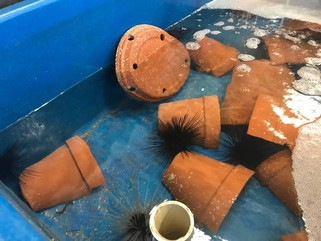
Left: PIT-tagged urchins acclimate to tags in tanks set up to mimic the artificial shelter they will be transplanted to on Delta Shoal
This project is the latest in a progression of work supported by FWLI that seeks to improve our understanding of the role herbivory plays in coral reef ecology and how we can harness that role to restore Florida’s reefs. Previous projects determined the importance of long-spined urchins to macroalgae control and revealed the high mortality of urchins released on degraded reefs due to predation. By building on that suite of research, this project aims to facilitate more effective restoration and enhance our understanding of herbivory on reefs.
|
Back to Top
by Amy Clifton

Rafinesque’s big-eared bat (Corynorhinus rafinesquii) is considered a Species of Greatest Conservation Need whose Florida range is not well known. There are scattered, isolated populations, but given the difficulty to detect them on an acoustic monitor and their low capture rate during mist netting surveys, there is a possibility this species occurs at a more expanded range than previously thought. Big-eared bats (CORA) are considered “whispering” bats due to their low intensity calls, which can be easily drowned out by other bat species such as Brazilian free-tailed bats (Tadarida brasiliensis) foraging nearby and therefore potentially missed during typical acoustic surveys. Rafinesque’s big-eared bats are the only Florida bat species that can “glean” by picking insects directly off leaves at tree canopy height. Given this unique foraging style, they may be missed on acoustic surveys if the microphone is not correctly placed. This also makes it possible to miss them during mist netting surveys if the arrays are not placed in travel corridors such as creeks.
I attempted to record this species on an acoustic monitor by placing the recorder near a known CORA roost in central Florida. The monitor settings were adjusted so the likelihood of recording this species was improved. After a week of recording, I analyzed the data using bat acoustic software that allows specific species to be selected or unselected.
The analysis was run in three ways:
- Using all Florida bat species qualifiers
- Using only big-eared bat qualifiers
- Using big-eared bat and Brazilian free-tailed bat qualifiers
There were different results for each analysis with the highest number of big-eared bat calls for analysis 3 and none for analysis 1. Investigation will continue into this issue.
|
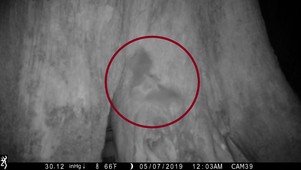
CORA is known to roost in large, hollow bald cypress and tupelo trees in bottomland hardwood forests and swamps. These large trees were common prior to logging operations in the early 1900s, which resulted in the removal of vast forests of very large cypress trees likely to be older than a 1,000 years. Larger, older cypress trees are more likely to be hollow and thus potential roosting sites for CORA. It is possible this species’ range was more widespread prior to logging operations. There are still some large, hollow cypress trees in Florida, but they are scattered and isolated.
I attempted an alternate survey method using a game camera at a large, hollow bald cypress tree. I have not been able to find records of anyone attempting this method for this species. I surveyed for suitable hollow trees near a known CORA roost in central Florida and placed a game camera at the base of the tree for one week. Considering this bat’s unique physical characteristic (large ears), I wanted to test if they could be identified in game camera pictures. CORA was not detected, but I did record a bat that clearly had small ears. I plan to continue performing surveys in areas of known CORA roosting to help determine their potential range.
|
Back to Top
by Andrea Alden
Florida’s Wildlife Legacy Initiative is excited to announce projects recently selected to receive State Wildlife Grant funding! During the past year, FWLI Goal Teams have worked with numerous external and internal partners in developing project scopes of work, drafting and posting announcements, and reviewing submissions. The proposed awards, listed below, total $1.74 million and will help FWLI achieve its new Implementation Goals. All projects began in July 2019.
|
Goal
|
Project Title
|
Affiliation
|
|
Terrestrial Habitat Integrity
|
|
|
| |
Florida Forest Service Cooperative Burning and Resource Assistance (COBRA) Team
|
FFS
|
| |
Improving Risk Management to Increase Private Land Burning - Technical Support
|
Tall Timbers
|
|
|
Quantity and quality burns at Kissimmee Prairie Preserve State Park
|
DEP
|
|
Aquatic Habitat Resiliency
|
|
|
| |
Peace River streambank restoration and Myakka watershed threats and fish community assessment and fish assemblage monitoring
|
FWC
|
|
|
Restoring fire-maintained wetlands
|
The Longleaf Alliance
|
|
Marine & Estuarine Habitat Enhancement
|
|
|
| |
Tarpon Cove Estuarine Habitat Restoration
|
Palm Beach County
|
| |
Habitat enhancement and erosion control adjacent to a critical coastal road using a living shoreline approach
|
UF
|
| |
Large Orbicella gamete collection and laboratory rearing
|
Nova Southeastern University
|
| |
Oyster-Based Living Shorelines in Florida State Parks
|
Marine Discovery Center
|
|
|
Jensen Beach Impoundment Mangrove Restoration Project
|
Martin County
|
|
Research & Monitoring
|
|
|
| |
Continuation of the Oyster Integrated Mapping and Monitoring Program
|
FWC
|
| |
Florida's Integrated Mapping & Monitoring Programs
|
FWC
|
| |
The effects of prescribed fire in salt marsh on imperiled avian and mammalian species
|
FWC
|
| |
Distribution, ecology, and habitat requirements of the blue calamintha bee
|
UF
|
| |
|
|
FWLI thanks all FWC staff from many sections as well as external partners without whom the latest State Wildlife Grants cycle would not have been successful. FWLI also thanks the U.S. Fish and Wildlife Service’s Florida field offices and the Region 4 office in Atlanta for assistance and providing the funding that makes these projects possible.
If you are interested in State Wildlife Grant funding, contact Florida’s Wildlife Legacy Initiative.
Back to Top
We don't always take enough time to celebrate hard work and amazing accomplishments. While not an exhaustive list, Florida’s Wildlife Legacy Initiative is recognizing the following principal investigators who finished their State Wildlife Grant-funded projects since the last newsletter publication. These projects demonstrate the wide variety of conservation efforts taking place in Florida – from research and on-the-ground restoration to management, mapping and monitoring. For more information on the following projects, please contact Andrea.Alden@MyFWC.com or Robyn.McDole@MyFWC.com
Congratulations to all on work well done!
Altering Hydrology in Breeding Ponds to Benefit Imperiled Amphibians During Drought
Brooke L. Talley, Ph.D., Florida Fish and Wildlife Conservation Commission and Ryan Means, Director Coastal Plains Institute
The Apalachicola National Forest region of northwest Florida is characterized by rolling sandhills containing many isolated, depressional wetlands whose water supply is driven by fluctuations in the underlying aquifer. With the aim to help recover imperiled amphibian populations, we wanted to test whether pre-installed synthetic rubber pond liners would increase the length of time water was held and if this extended hydroperiod would enhance amphibian breeding activity.
We installed three lined ponds and monitored them along with three unlined natural ponds for six months out of each of three consecutive years (2017-2019). Monitoring included water levels, rainfall, and amphibian breeding. Analysis of hydrological and amphibian monitoring data showed that lined ponds held water significantly longer than unlined ponds and experienced increased amphibian breeding. Lined ponds, having an artificial confining layer impermeable to water, acted as shallow catchments persistently pooling rainwater. Unlined ponds filled infrequently, acting like sieves that allowed for rapid percolation of rainwater into the ground.
|